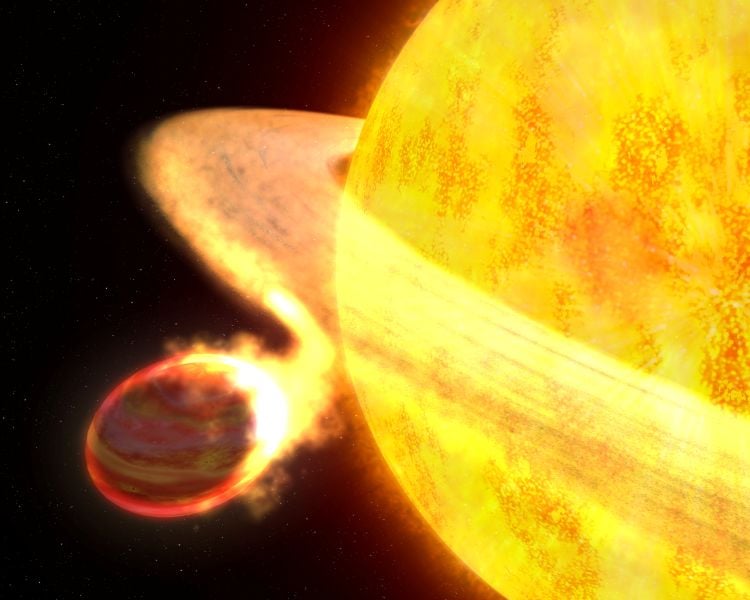Science
Scientists Uncover Atmospheric Escape of Exoplanets Around F-Type Stars

A recent study published in *The Astronomical Journal* has shed light on the atmospheric escape of exoplanets orbiting F-type stars. An international team of scientists conducted a pioneering investigation into this phenomenon, focusing on how the intense heat and radiation from these larger and hotter stars strip away planetary atmospheres.
F-type stars, which are significantly more massive and hotter than our Sun, present unique conditions for planets in their close orbits. For this study, researchers analyzed data from ten transits of six exoplanets, utilizing the Wide-field Infrared Camera (WIRC) at the Palomar Observatory, operated by the California Institute of Technology. The six exoplanets involved were chosen for their proximity to their host stars, making them ideal candidates for studying atmospheric escape.
The primary objective was to determine the extent of atmospheric loss these exoplanets experience. The results indicated that both WASP-12 b and WASP-180 A b exhibited significant atmospheric escape. In contrast, WASP-93 b and HAT-P-8 b showed potential signs of atmospheric loss, while WASP-103 b and KELT-7 b showed no detectable atmospheric escape.
By comparing their findings with established computer models, the researchers calculated atmospheric escape velocities for WASP-12 b and WASP-180 A b, measuring approximately 12.4 grams per second and 11.85 grams per second, respectively. This translates to escape velocities of approximately 10^12.4 and 10^11.85 grams per second. These figures underscore the significant dynamics at play in the atmospheres of gas giants orbiting closely to F-type stars.
Understanding Exoplanet Evolution and Habitability
Historically, studies on atmospheric escape have mainly focused on exoplanets orbiting cooler K- and M-type stars. The shift to examining F-type stars is crucial, as these stars exert far more heat and radiation on their surrounding planets. The research contributes to a broader understanding of how exoplanets evolve over time, particularly those classified as “hot” Jupiters and “ultra-hot” Jupiters.
The implications of this study extend beyond atmospheric dynamics. Understanding atmospheric escape provides insights into star-planet interactions, the composition of exoplanetary atmospheres, and even potential habitability. Additionally, the research serves to validate existing planetary models, emphasizing the importance of atmospheric escape as a tool for exploring exoplanet formation and evolution.
As scientists continue to investigate the atmospheres of exoplanets around F-type stars, future studies may reveal even more about the mechanisms of atmospheric stripping and the long-term viability of these distant worlds. As the field progresses, the quest for knowledge regarding the universe and our place within it remains a driving force in scientific inquiry.
-

 Science2 weeks ago
Science2 weeks agoIROS 2025 to Showcase Cutting-Edge Robotics Innovations in China
-

 Politics2 weeks ago
Politics2 weeks agoJudge Considers Dismissal of Chelsea Housing Case Citing AI Flaws
-

 World2 weeks ago
World2 weeks agoBravo Company Veterans Honored with Bronze Medals After 56 Years
-

 Lifestyle2 weeks ago
Lifestyle2 weeks agoStone Island’s Logo Worn by Extremists Sparks Brand Dilemma
-

 Top Stories2 weeks ago
Top Stories2 weeks agoIndonesia Suspends 27,000 Bank Accounts in Online Gambling Crackdown
-

 Health2 weeks ago
Health2 weeks agoStartup Liberate Bio Secures $31 Million for Next-Gen Therapies
-

 Sports2 weeks ago
Sports2 weeks agoMel Kiper Jr. Reveals Top 25 Prospects for 2026 NFL Draft
-

 Health2 weeks ago
Health2 weeks agoTop Hyaluronic Acid Serums for Radiant Skin in 2025
-

 World2 weeks ago
World2 weeks agoHoneywell Predicts Record Demand for Business Jets Over Next Decade
-

 Sports2 weeks ago
Sports2 weeks agoYamamoto’s Mastery Leads Dodgers to 5-1 Victory in NLCS Game 2
-

 Politics2 weeks ago
Politics2 weeks agoNew Jersey Voters Urged to Register Ahead of November Election
-

 Lifestyle2 weeks ago
Lifestyle2 weeks agoMary Morgan Jackson Crowned Little Miss National Peanut Festival 2025









